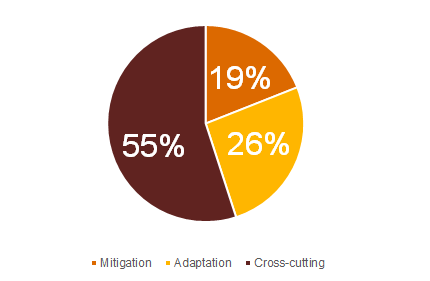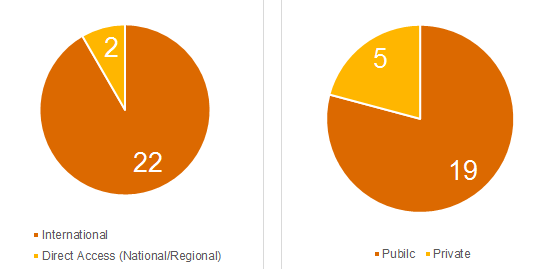Climate finance challenges 2016
Climate finance challenges 2016
Ben Bostock, CDKN project manager, assesses the landscape of climate finance after the Paris climate summit - and in the run-up to the next major United Nations climate talks in Marrakech in November. He looks at whether the Green Climate Fund is set to meet its targets and the challenges it faces.
The Paris Agreement in December 2015 signalled a global response towards tackling climate change. As we look to realise action at ground level, significant amounts of money will need to start flowing towards climate programmes. A goal of providing $100 billion in available global climate finance annually by 2020 – funds available specifically for projects and programmes aimed at combatting climate change – was outlined in the agreement. This will be catalytic to unlocking the trillions of dollars which will be ultimately required to bring about transformational change.
What are some of the key global institutions for climate finance?
CDKN has been working with Germanwatch, who run the Climate Finance Advisory Service – which provides expert input to negotiators at the board meetings of three key global climate finance bodies:
The Adaptation Fund focuses specifically on financing projects dealing with adaptation – as opposed to mitigation. Established in 2001, it has a mandate towards funding programmes which concentrate on resilience and adaptation to changes which have already been realised through global warming – as opposed to funding programmes which mitigate against further global warming. The fund is financed partly by Government and private donors, as well as via receiving a portion of the income created through the Kyoto Protocol’s carbon credits scheme.
So far, the fund has committed over $350 million across 61 countries towards climate resilience and adaptation initiatives. In the coming years, Naresh Sharma of Nepal – the Fund’s new Chair – outlines that it aims to focus more specifically on climate innovation, and on targeting the most climate vulnerable countries.
The Standing Committee on Finance (SCF) is not a fund-dispersing body – but is instead more like an expert panel which provides recommendations and key analytics. Its creation was an outcome of COP 16 in Cancun (2010) – and was mandated with directly advising the COP on climate finance issues. Its purpose is to improve the coherence and coordination of climate finance, as well as to help mobilise financial resources and to carry out measurement, reporting and verification (MRV) of climate finance which is provided to developing countries.
Looking forward, the SCF has been mandated to meet at least twice per year – one of which will be at COP22 in Marrakesh - to provide recommendations to the UNFCCC on these key areas. It will also continue to produce its biennial assessment on geographical and thematic climate finance flows of the past 6 months.
Perhaps the most well-known and widely purposed climate finance entity, the Green Climate Fund (GCF) was also established at the Cancun COP in 2010. It is a standalone, multilateral entity which aims to deliver equal spending to both climate mitigation and adaptation initiatives. The GCF is accountable to the UN’s Framework Convention on Climate Change (UNFCCC) – which specifically mentioned it as being “entrusted with the operation of the Financial Mechanism” of the UNFCCC. To do so, the body approves of, or ‘accredits’ entities from across the world, assessing whether they are able to financially manage and safeguard projects against environmental or social issues. Once accredited, these entities can subsequently administer climate finance to projects and programmes of all sizes.
Currently, 33 entities have been accredited by the GCF, and this group is a varied mix of private and public, international and national bodies, from both developed and developing countries. Some examples include the National Environment Management Authority of Kenya, the Caribbean Community Climate Change Centre, Ethiopia’s Ministry of Finance and Economic Cooperation, as well as HSBC and the World Bank.
The GCF is looking to rapidly increase its pledged funding from developed nations, in order to increase from the current $10 billion towards the $100 billion annual target set out in the Paris agreement.
Spotlight on the Green Climate Fund – What challenges are currently being faced?
As the chief body charged with ultimately overseeing the provision of $100billion in climate finance annually, the GCF will be the centre of attention for many years. But what challenges does it face half a year on from the Paris agreement?
Regarding the twin agendas of adaptation and mitigation, the GCF has declared that it intends to reach a 50:50 split in funding between the two. The thematic split of project concept notes the GCF board has received shows a relatively even split between these which shows that both issues are being evenly accounted for. However – an ambiguity exists, which is often brought up in board meetings – as a third ‘cross-cutting’ categorisation exists for proposals. This broad catch-all term could lead to controversy as more and more projects are approved under this categorisation. It will be harder and harder to quantify the spending split of adaptation vs. mitigation – which could lead to controversy over the GCFs funding patterns in future.
Thematic distribution of concept notes in GCF funding (%)
Source: GCF/B.13/Inf.10 - Status of the Fund’s portfolio: pipeline and approved projects http://www.greenclimate.fund/documents/20182/226888/GCF_B.13_Inf.10_-_Status_of_the_Fund_s_portfolio__pipeline_and_approved_projects.pdf/5b60672e-3163-4a60-ba1e-e2770eaa15dd?version=1.0
Given the relatively new global climate finance landscape under the UNFCCC, the GCF is looking hard pushed to programme its targeted figure for 2016. Out of its current $10.3 billion pot, the fund aims to spend $2.5 billion this year – but so far has managed a total of around $250 million. This is due in part to the time taken to accredit entities, as well as the projects and programmes which these entities then put forth for approval. Omar El Arini, the GCF board member for Egypt, noted at the latest board meeting in June that of the 33 accredited entities, only 10 had gotten around to submitting funding proposals. This progress may seem slow in a quantitative sense – however, it is important for the process of accreditations and approvals to not be rushed, especially at the early stages. Setting a high benchmark for the required financial management of projects will be key to laying out the expectations in delivery for future funding.
If the GCF were to rush to meet its $2.5 billion target, it could risk concentrating too heavily on larger scale national level programmes managed via multilateral organisations. Currently, the majority (58%) of accredited entities are international, with the Direct Access Entities making up 27% of the total at national level and 15% at regional. Accordingly, of the funding which is being considered or has already been approved, the vast majority focuses on large international programmes – for example of the 9 projects approved so far in 2016, 7 are being run with the UN or the World Bank. This is in part due to the number of large multilateral entities which are accredited, but also due to the increased risk of smaller, regional entities and programmes which may take longer to become accredited, and to gain programme approval. As such –just as Pakistan representative Farrukh Khan commented in 2014, patience may still be the best option – in order to ensure that national and regional entities are included in the process.
There are a number of ways that the GCF could ensure that this local and regional level is not forgotten in the long run – perhaps through ring-fencing some funding for particular community-based projects, or by channelling some funding through devolved climate fund entities. Furthermore, ensuring that accreditation is accessible for all levels of entity, ensuring that national, and especially region, entities can be accredited as well will help in this regard. Given the trend of rapid urbanisation across many developing countries, cities could become very effective hubs for implementing climate finance programmes – so focussing at this level could be a good idea.
Ali’ioaigi Feturi-Elisaia - the board member for Samoa - warned against limiting the number and type of accredited entities – as this could risk monopolizing access of GCF resources to large, developed country based multilaterals – which have thus far received the lion’s share of funding approval. He noted that the private sector, and developing country Direct Access Entities, should be prioritised – as these are currently very much in the minority of total proposals.
Pipeline of Funding Proposals with a >50% probability of presentation to the GCF Board by mid 2017 (total: 24)
Source: GCF/B.13/Inf.10 - Status of the Fund’s portfolio: pipeline and approved projects http://www.greenclimate.fund/documents/20182/226888/GCF_B.13_Inf.10_-_Status_of_the_Fund_s_portfolio__pipeline_and_approved_projects.pdf/5b60672e-3163-4a60-ba1e-e2770eaa15dd?version=1.0


